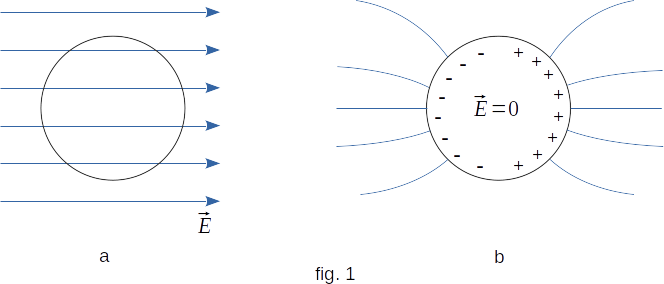From the Electrostatics
72. Conductors in the electrostatic field
Free charges.
In conductors, which primarily include metals, there are charged particles that can move freely inside the conductors under the influence of an electric field. For this reason, the charges of these particles are called free charges.In metals, electrons are the carriers of free charges. In the formation of a piece of metal from the neutral atoms due to the interaction between them electrons of the outer shell of the atom completely lose contact with "their" atoms and become "property" of the whole piece. As a result, positive ions are surrounded by a negative "gas" formed by the collected electrons. This gas fills the gaps between the ions and tightens them by Coulomb forces. The electrons can move on a piece of metal in any direction.
Electric field inside the conductor.
If the electrical charges are stationary (electrostatic case), there is no electric field inside the conductor. It's not hard to understand why. There are free charges inside the conductor. Therefore, if there were a field, it would drive these charges and there would be an electric current. If there is no current, there is no field.The mechanism that leads to the destruction of the electrostatic field in the conductor is as follows. Introduce a conductive sphere into the electrostatic field (fig. 1a). At the first moment the field will penetrate into the sphere and will cause movement of electrons, i.e. electric current. But soon this current will stop. Electric charges will be redistributed so that their field in total with the external field inside the conductor becomes equal to zero. Otherwise the current would never stop and the conductor would produce heat all the time, which is impossible from the point of view of the law of energy conservation.
And if the charge on the conductor is in equilibrium, the power lines of the electric field outside are perpendicular to the surface of the conductor (fig. 1b). Otherwise, there would be a component of electric field strength along the surface and current would flow on the surface. The field perpendicular to the surface of the conductor arises from the addition of the external field and the field created by the redistributed charges of the conductor.
So, the electrostatic field does not penetrate into the conductor. This is the basis for the so-called electrostatic protection. To protect the devices sensitive to the field, they are enclosed in metal boxes.

Electric charge inside the conductors.
In case of equilibrium of charges not only the field inside the conductor is equal to zero, but also to zero and the charge. All charge of the conductor under condition of equilibrium is concentrated on its surface. That the charge accumulates on the surface of the conductor looks natural. After all, the same charge sign is repulsed and, trying to get away from each other at the maximum distance, should, it would seem, always gather on the surface. However, the charge proves to be equal to zero inside the conductor only because the force of interaction of charges is strictly inversely proportional to the square of the distance. In any other law of interaction, the charge inside the conductor would not be equal to zero.With the help of power lines, whose density is proportional to the field strength, it is possible to explain the absence of electrostatic charge inside the conductor. In fact, if such a charge was located somewhere inside the conductor, then the power lines emitting from it would necessarily be available at least in a small neighborhood near the charge. Consequently, there would also be a field. But there is no electrostatic field inside the conductor. And this means that charges can only be placed on its surface.
On the surface of the conductor itself, the charge is unevenly distributed. It has the highest density on the sharp points.